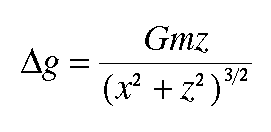Gravity Anomaly Over a Buried Sphere
It can be shown that the gravitational attraction of a spherical body of finite size and mass m is identical to that of a point mass with the same mass m. Therefore, the expression derived on the previous page for the gravitational acceleration over a point mass

also represents the gravitational acceleration over a buried sphere. For application with a spherical body, it is convenient to rewrite the mass, m, in terms of the volume and the density contrast of the sphere with the surrounding earth using

where v is the volume of the sphere,  is
the density contrast of the
sphere with the surrounding rock, and R is the radius of the sphere. Thus, the
gravitational acceleration over a buried sphere can be written as
is
the density contrast of the
sphere with the surrounding rock, and R is the radius of the sphere. Thus, the
gravitational acceleration over a buried sphere can be written as

Although this expression appears to be more complex than that used to describe the gravitational acceleration over a buried sphere, the complexity arises only because we've replaced m with a term that has more elements. In form, this expression is still identical to the gravitational acceleration over a buried point mass.
Gravity
- Overviewpg 12
- -Temporal Based Variations-
- Instrument Driftpg 13
- Tidespg 14
- A Correction Strategy for Instrument Drift and Tidespg 15
- Tidal and Drift Corrections: A Field Procedurepg 16
- Tidal and Drift Corrections: Data Reductionpg 17
- -Spatial Based Variations-
- Latitude Dependent Changes in Gravitational Accelerationpg 18
- Correcting for Latitude Dependent Changespg 19
- Vari. in Gravitational Acceleration Due to Changes in Elevationpg 20
- Accounting for Elevation Vari.: The Free-Air Correctionpg 21
- Variations in Gravity Due to Excess Masspg 22
- Correcting for Excess Mass: The Bouguer Slab Correctionpg 23
- Vari. in Gravity Due to Nearby Topographypg 24
- Terrain Correctionspg 25
- Summary of Gravity Typespg 26